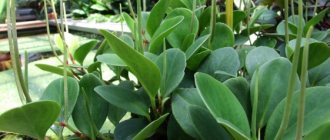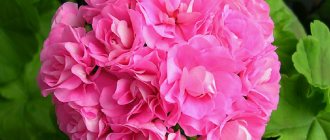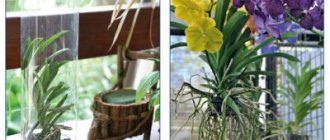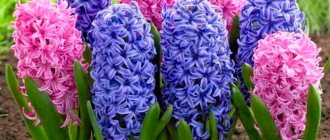Growing this beauty as a houseplant is not difficult if you follow basic care rules.
Below you can see the Murraya in the photo along with flowers:
Features of Muraya
In the wild, paniculata muraya, also called paniculata muraya (Murraya paniculata), is an evergreen shrub or tree, reaching a height of 7 meters, while the trunk is approximately 13 centimeters in diameter. This species also has low-growing forms, the height of which does not exceed 200 cm. The glossy, smooth, odd-pinnate leaf plates are complex, they consist of 3–9 leaflets. The foliage has a pleasant smell. The surface of young foliage has pubescence, while the surface of mature leaves is smooth. Fragrant flowers, up to 20 mm in diameter, can be painted cream or white; they have 5 petals that are bent back. The fruit is a small red berry that is fully ripe approximately four months after emergence. At the same time, blooming flowers, buds, and also berries may be present on the bush. Under natural conditions, this species can be found in Southeast and South Asia, the islands of Java and Sumatra, Northern Australia, Taiwan, India, Malacca, the Philippines, Southern China and the southern part of the USA.
Muraya: description of the flower
Muraya paniculata is most often grown indoors (see photo in the article). It is a fast-growing shrub with feathery, fleshy, deep green leaves. If you rub the plate, you can smell the citrus aroma.
The trunk is embossed, light, marble in color. Young shoots are covered with soft down, adults are smooth.
Snow-white or milky flowers with five petals are formed at the tips of the branches. Single or collected in inflorescences, 1.8-2 cm in diameter. They are replaced by edible elongated berries of a bright scarlet hue, 1.5-3 cm in size, slightly reminiscent of hawthorn in shape. The ripening period lasts 4 months.
Several species of Muraya paniculata are grown at home:
- "Dwarf". It is distinguished by miniature leaves, which are collected in 3-5 pieces and form a complex leaf. The trunk is slightly curved and highly branched. The height of an adult tree is no more than 50 cm.
- Slightly larger than "Min-a-min". Its complex sheet consists of 5-7 plates. The plant is sterile and does not produce seeds when flowering.
- A very tiny variety “Dwarf Compact”. It stretches no more than 15 cm in height, the diameter of the leaves is up to 5 mm.
Very often you can find an advertisement for the sale of the “Dutch” species. In fact, this is not a separate variety, but just a flower brought for sale from abroad.
Muraya Koeniga in nature grows up to 6 meters in height, with a trunk girth of 40 cm. The inflorescences contain up to 80 flowers that emit a strong aroma. Black berries are not eaten. Despite the fact that the pulp is edible, there is a poisonous seed inside the fruit.
Interesting: Ficus benjamina: home care, reproduction, diseases
Interesting! Muraya, also known as Japanese myrtle and orange jasmine, blooms almost all year round. Indian girls decorate their hair with flowers during marriage ceremonies, make living necklaces, and decorate temples and sanctuaries for various holidays and festivals.
Growing muraya from seeds
It is very easy to grow Muraya from seeds indoors. At the same time, you should know that the seed remains viable for a relatively long time. Before sowing, the seeds should be kept in lukewarm water for 2 hours, then they should be evenly distributed over the surface of a moistened soil mixture, which includes sand and peat (1:1). You can also grow seedlings in peat tablets or a soil mixture consisting of sand and leaf soil. There is no need to bury the seeds in the substrate; they should be covered on top with a thin layer (0.5–1 cm) of soil mixture. The containers need to be covered with glass or film on top, then they are transferred to a well-lit place where there is no direct rays of the sun, and the air temperature should be from 22 to 28 degrees. The first seedlings should appear 30–40 days after sowing, and after they have formed 3 true leaf blades, the plants should be planted in individual pots. Muraya, grown indoors, is distinguished by its undemanding nature.
Muraya from berries. Sowing seeds. Shoots
Selection of location and conditions of detention
Muraya is a rather capricious indoor flower that requires strict adherence to maintenance conditions. Let's find out what Muraya loves and what should absolutely not be allowed.
Lighting and location
Murraya loves plenty of diffused light. But she is afraid of direct rays of the sun. The best location for a pot with this tree is on an eastern window sill. On a western window it will be worse, since morning radiation has a better effect on photosynthesis. You cannot place a flower on a north window or in the back of the room - from lack of lighting it will begin to shed its leaves.
If you put it on a southern window sill, then build an artificial shadow every day at midday. If there is no shading, the muraya cannot be taken out onto the balcony or into the open air.
Advice! To ensure that Murraya blooms and bears fruit all year round, provide it with artificial lighting from September to May. The total daylight hours should be at least 12 hours.
Temperature
The optimal temperature for growing citrus bushes is +22…+25 oC. In winter it is better to lower it to +15…+20 °C. Muraya does not tolerate cold and extreme heat, especially if the indoor air is too dry.
Air and humidity
Muraya loves high air humidity (70-80%). But it is not easy to achieve such a value throughout the entire room, especially in winter. Therefore, to humidify the air around the tree itself, the pot with the plant is placed on a tray filled with wet expanded clay. Moisture evaporating from the stones will maintain the desired level of humidity.
Citrus plants like daily mistings with water at room temperature. And if the leaves are covered with a layer of dust, then it must be removed with a soft, damp sponge. You cannot place the tree in a draft.
Soil and pot
As soil, you can use a soil mixture specifically for citrus fruits. It is sold in flower shops. But muraya needs different soil depending on the age of the bush. Young plants need loose and light soil, while old plants need old, heavy soil. If you want to prepare the soil yourself, then mix 2 parts each of humus, leaf and turf soil, and then add 1 part of coarse river sand (washed from dust). The mixture is suitable for young trees.
The muraya pot should be quite tight. There should be no more than 2-3 cm of free space between the roots of the plant and the walls of the vessel. Typically, plastic pots with drainage holes at the bottom are used.
Important! The soil for muraya should have a slightly acidic reaction. Alkaline or highly acidic soils can cause citrus to die.
Caring for Muraya at home
Illumination
The room in which the flower is located must be systematically ventilated. The lighting should be diffused, but the bush can be in direct sunlight for 2 to 3 hours a day. In winter, you need to make sure that the muraya has enough light. Experts advise placing a flower near a window located in the eastern or western part of the room.
Temperature
In spring, summer and autumn, this plant needs warmth (from 24 to 28 degrees), and in winter the temperature in the room should be reduced to 17–20 degrees, because Muraya has a weak rest period.
Trimming
There is no need to trim or pinch the bush, since the plant is able to form its own crown on its own. However, in rare cases it may be necessary to shorten an overly long shoot. In order for the bush to have a beautiful shape, it must be systematically rotated along with the container around its axis.
How to water
In spring and summer, Muraya will need to be provided with abundant, but not frequent watering. At the same time, you need to water the bush only after the lump of earth has dried out by 1/3. Water is used without chlorine and soft (it is mixed with a small amount of citric acid). In autumn and winter, watering should be reduced, but the rules remain unchanged, namely, the bush should be watered only after the earthen ball has dried out by 1/3.
Air humidity
The air humidity in a city apartment is quite suitable for this flower, so it does not need to be moistened with a spray bottle every day. But you still need to spray the plants from time to time, especially on hot days.
Fertilizer
In spring and summer, Muraya needs systematic feeding: once every 15–20 days. In spring, the flower needs potassium and nitrogen, which promotes more active growth of green mass. It is recommended to use organic and mineral fertilizers alternately for fertilizing, but try not to overfeed the flower. In autumn and winter, fertilizers cannot be added to the soil mixture.
Transplanting muraya
Young specimens are transplanted every year. Adult plants are replanted once every 2 or 3 years, but every year in spring, experts advise replacing the top layer of soil mixture in pots. The pot should be chosen so that it is not too small or too large. The soil mixture must be loose and rich in nutrients. For example, to create it, you can combine turf and leaf soil, humus and sand in a ratio of 2:2:1:2. Muraya can also be transplanted into a ready-made soil mixture for citrus fruits. Don't forget to make a good thick drainage layer at the bottom of the container before planting. Transplantation is carried out using the transshipment method, while trying to ensure that the earthen lump does not collapse.
Bloom
During flowering, the bush opens a large number of pale cream or white fragrant flowers, reaching 20 mm in diameter. Blooming muraya is very spectacular and can become the main decoration of any room, especially considering that the flowering period is approximately 6 months (in some cases it lasts longer).
No flowering
Some gardeners complain that their muraya bush does not want to bloom. This may be due to various reasons. So, if Dutch muraya is grown, then you need to remember that from the moment of purchase to the first flowering it can take from 3 to 4 years. Also, the bush may not bloom because it is grown in an excessively cramped container; as a rule, after transplanting into a larger pot, the bush soon begins to bloom.
3.Varieties:
3.1.Muraya paniculata or foreign - Murraya paniculata
A large tropical or subtropical shrub or low tree up to 6 m. The plant has glossy dark green leaves, very fragrant white flowers and round red fruits. The leaves are compound, pinnate, have from 3 to 9 ovoid, alternately arranged segments up to 5 cm long. The flowers are collected in axillary inflorescences - racemes and can appear several times during the season. The aroma of flowers intensifies at night.
↑ Up,
Reproduction of Muraya
Muraya can be propagated by seeds. How to do this is described in great detail above. This plant can also be propagated by cuttings, but it should be noted that this method is unreliable. Semi-lignified cuttings are cut from one-year-old shoots. For rooting, cuttings should be planted in wet sand, perlite, peat, or they can be placed in a glass of water. The cuttings need warmth (from 26 to 30 degrees); they must be covered on top with a transparent polyethylene cap or glass jar. It will be very good if the cuttings are provided with bottom heating.
Muraya can be propagated by cuttings in September–November. Rooted cuttings need to be transplanted into individual pots filled with fertile, loose soil mixture, and a good drainage layer must be made at the bottom.
Seed preparation
Seeds of indoor Murraya species can be purchased in specialized stores. But it’s better if you collect or are given seeds from a specimen of a plant that you like, which is actively developing, constantly blooming and strewn with delicious, beautiful berries - then the guarantee that you will get what you want increases many times over.
For growing Muraya, the seeds of those fruits that have sung on the branches for 4 months are suitable.
The first and most important condition is that the fruits must be ripe. This means that the muraya “berries” acquire a bright red color. Greenish-red and, even more so, completely green fruits will not produce any shoots (checked several times). When the seeds are ripe, it is better not to overexpose them, so as not to start rotting right on the branches.
We wash the pulp, freeing the seeds. If there are any remaining pulp, carefully peel it off, rinse it in a strainer under running, warm water and place it in a depleted solution of Bordeaux mixture.
Diseases and pests of muraya
If the muraya does not have enough light, as well as with excessively low air humidity or improper watering, problems may begin with it. For example, a fungal disease may develop on a bush, or spider mites or scale insects may settle on it and feed by sucking cell sap from various parts of the plant. To destroy pests, muraya needs to be treated twice or three times with an acaricide solution (Karbofos or Actellik), and an interval of 7 days must be maintained between sessions. If the bush is affected by a fungal disease, then it must be sprayed with a fungicide solution (Fitosporin-M, Fundazol, Oksikhom or another drug with a similar effect). However, in order to cure a plant, it is very important to begin to properly care for it, as well as create optimal conditions for its growth and development.
Muraya leaves turn yellow: what to do
Leaves may turn yellow if the soil is highly alkaline or lacks beneficial microelements. The plant also sheds its leaves due to a sharp change in temperature, natural aging, lack of sufficient watering, excessive oversaturation of fertilizers, and improper care. A plant can turn yellow, fall and shed its leaves due to improper transplantation, for example, into a pot that is too spacious. Yellowing of the leaves may be due to chlorosis (a common disease of shrubs).
To prevent the plant from getting sick, you need to provide moderate watering with settled water, monitor useful additives for the absence of chlorine in the composition.
In general, an exotic citrus plant can decorate any room with its appearance. It is not difficult to care for, the main thing is to plant it in a large pot, water it on time and take preventive measures against diseases, otherwise it may shed its beautiful leaves and flowers.
Types and varieties of muraya
It was already mentioned above that indoor gardeners cultivate only varieties of Muraya paniculata, for example:
- Min-a-min . This variety is a compact form of the Smart Choice garden variety. The height of this bushy plant is about 100 cm and is characterized by rapid growth. In regions with a mild, warm climate, this variety can also be grown in the garden, creating magnificent hedges.
- Minima . The height of such a miniature plant is from 0.4 to 0.6 m, it is characterized by slow growth, and its flowering begins already in the first year of life. This variety is excellent for growing indoors.
- Dwarf Compact . This is a dwarf variety, the height of the bush does not exceed 10–15 centimeters, the length of the oval leaf blades is about 0.5 cm. This variety is considered the most demanding in terms of care and growing conditions.
You can sometimes find advertisements that offer to purchase Dutch muraya. But this is just Muraya paniculata, which was brought from Holland for sale.
Caring for Muraya at home
Features of using indoor plants in other situations
In cooking
Its strong citrus and lemon aroma makes it very popular in cooking. Murraya nigrum leaves are similar to a curry spice and are used in cooking. Its aroma complements the taste of dishes. Murraya is suitable as an addition to salads and appetizers, vegetable and meat dishes. The medicinal properties of the inside of the plant are wide ranging: heart disease, high blood pressure.
In cosmetology
Today, when caring for face and body, women give preference to natural products, of which there are plenty in the plant world. It is not surprising that such a unique plant is successfully used in cosmetology. Fresh leaves are the main source for cosmetic use. Daily consumption of 3-5 muraya fruits is a prevention of aging. The skin will be hydrated and elastic for a long time. A decoction of the plant's inflorescences is beneficial for aging facial skin. To prepare the decoction, you need to pour a handful of inflorescences with boiling water and leave for several hours. In the morning, wipe your face with the infusion. The solution can be stored in the refrigerator for several days. The results of this procedure will be quickly noticeable.
The essential oil of this plant can be added to hair shampoos, creams, lotions, 3-4 drops per tablespoon of base. One of the useful face masks: muraya and turmeric essential oil. This is a healing mask that helps get rid of acne. Your facial skin will become clear and elastic, and your pores will shrink. Apply this mask to problem skin. You can make natural hair dye from leaves and coconut oil. All this should be boiled. This composition dyes gray hair, strengthens hair roots and improves their growth. Girls in India are known to have healthy and long hair. They use special masks based on muraya leaves.
At home
Muraya is also used in everyday life. As a beautiful ornamental plant, it is a decoration for the home. Dwarf varieties can be used to create bonsai. Muraya with black fruits repels insects. Due to the wonderful aroma of flowers and leaves, it can be used as an ingredient in perfumery. Muraya is one of the most undemanding indoor plants. Nowadays, it is easy and inexpensive to buy shrubs in a store, and in return you will receive a fragrant aroma and joy for the eyes.
Properties of muraya: harm and benefit
Medicinal properties of muraya
Already in Ancient Egypt they knew that muraya had medicinal properties. There are many myths about this plant, and the history of its origin is shrouded in mystery. But what is the use of this plant, called the “tree of Japanese emperors”? The foliage contains hesperidin - this bitter glycoside affects capillary permeability. This plant also has an anti-inflammatory, strengthening and wound-healing effect, so it is used in alternative medicine for gastritis, diarrhea, dysentery and other diseases of the gastrointestinal tract, as well as for various wounds. The leaves are also used externally for pain and aching joints. And the juice obtained from the leaves effectively eliminates headaches and toothaches. The berries of this crop contain biologically active substances, namely: antioxidants and vitamins. If you eat 3 or 4 of these fruits per day, this will be an excellent prevention of premature aging. They are also used for coronary heart disease, hypertension and other diseases of the cardiovascular system. They are also indicated for diabetes mellitus, because they help reduce blood sugar without the use of medications.
Making a muraya tincture is very simple; to do this, you need to take the berries and leaves in equal weight proportions. To begin with, the seeds are removed from the berries, then they and the leaves are crushed. The resulting mass is poured into a glass vessel into which vodka is poured, adding 2-3 tbsp. l. the mixture takes 0.25 liters of vodka. The tightly sealed vessel is placed in a cool and dark place for 15 days, and the liquid must be shaken systematically. The finished tincture is taken 20–30 drops twice or thrice a day for 30 minutes. before the meal. It helps with heart failure, coronary heart disease, frequent migraines and as a preventive measure against myocardial infarction.
Useful properties of the plant
In countries where Murraya grows naturally, local beauties often use the inflorescences as hair decorations.
Orange jasmine petals are indispensable in the manufacture of many seasonings, because curries are made from them.
If you do not want to get a large tree, which can happen very soon, the plant's growth should be regulated by limiting the volume of the planting container.
Freshly picked shoots and fruits are used in the preparation of medicinal decoctions and tinctures. They contain a large amount of useful substances, so ready-made preparations are used to strengthen the walls of blood vessels. Inhaling the aroma of inflorescences is recommended for angina pectoris. It also normalizes sleep and calms the nervous system.
Antioxidants have a stimulating effect and help fight fatigue.
Experts advise placing a pot with a flowering tree on the desktop or placing it next to the crib - the phytoncides secreted by the plant stimulate brain activity, elevate mood, and prevent the development of viral diseases.
To give shape and limit the growth of long shoots, muraya is pruned, although such intervention is rarely necessary - muraya successfully copes with the formation of its own crown on its own.
Murraya flowering and fruiting
I have many specimens of Murraya paniculata of different ages, large plants and young ones, photos of Murraya from different bushes. Murraya Paniculata (Russia) – seed cycle in home cultivation:
Murraya paniculata (Russia) in buds, 03/17/2016
Murraya paniculata has bloomed and set, 05/20/2016
Murraya paniculata - one and adult bushes in bloom 03/18/2016
Murraya paniculata (Russia) - fruiting of an adult bush, 03/17/2016
Murraya paniculata - ripe fruits, 05/03/2016
Flowering of young Murraya, 03/17/2016
The flower is ready for pollination - the pollen is ripe, 03/17/2016
Two seeds in the fruit - bloomed and set - from the cradle, 05/20/2016
Another Murraya blooms from the cradle, 05/20/2016
The pollen of this Murraya flower has not ripened, 05/20/2016
Proper pruning
Pruning should begin at the end of February and continue to form the crown throughout the spring. There are always buds and berries on the flower, so it makes no sense to wait for the moment when the bush fades.
The main rules for pruning Muraya:
- Do not touch lignified branches, otherwise they will die.
- Green young branches should be shortened only by 1/3. If this condition is neglected, the shoot will dry out.
- Do not cut off all the extra branches at one time, form the crown gradually.
- In young bushes, be sure to pinch shoots with buds. Repeat pinching several times until the young Murayai gain sufficient vegetative mass.
Leaves and buds can be brewed into tea. They give the drink a pleasant aroma and additional healing properties.
To grow a plant not as a bush, but as a tree, you need to methodically cut off its excess branches. When Muraya grows to the desired height, place the pot on the floor next to the window.
Miniature varieties are trimmed less, large species are trimmed a little more. But this procedure is necessary for all varieties. It stimulates the formation of buds and increases the bushiness of the plant.
A dwarf variety to which bonsai growing and pruning techniques were applied
Popular questions and answers
When growing Muraya paniculata, problems often arise. We addressed the most typical questions on this matter to agronomist-breeder Svetlana Mikhailova.
How to choose muraya?
Carefully inspect the plant - it should look healthy, without signs of diseases or pests. If possible, remove a lump of earth from the pot and inspect the roots - it is important that they are not rotten.
What kind of pot is needed for muraya?
It should not be very large - Muraya does not like stagnant water, and if the container is too spacious, the water in it may stagnate, which will lead to root rot. But the pot should not be too cramped - in this case the tree will not bloom.
Why do muraya leaves fall?
There may be several reasons: - the soil is too dry; — there is not enough light; - the roots have rotted; - the plant is affected by pests.
Why do Muraya leaves turn yellow?
This can happen due to lack of moisture. This often happens in winter - the plant seems to be watered, the soil is damp, but the pot is on a cold windowsill and the soil in it is cold. In such conditions, the roots are not able to absorb water and the plant suffers from drought. The second reason is pests.
Sources
- Plant taxonomy. Rutaceae. Muraya // The Plant List https://www.theplantlist.org/1.1/browse/A/Rutaceae/Murraya/
- Pokhlebkin V.V. All about spices. // M.: Food industry, 1974. – 207 p.
- Wulf E.V., Maleeva O.F. World resources of useful plants // L.: Nauka, 1969. – 568 p.
- State catalog of pesticides and agrochemicals approved for use on the territory of the Russian Federation as of July 6, 2022 // Ministry of Agriculture of the Russian Federation
- https://mcx.gov.ru/ministry/departments/departament-rastenievodstva-mekhanizatsii-khimizatsii-i-zashchity-rasteniy/industry-information/info-gosudarstvennaya-usluga-po-gosudarstvennoy-registratsii-pestitsidov-i-agrokhimikatov/











